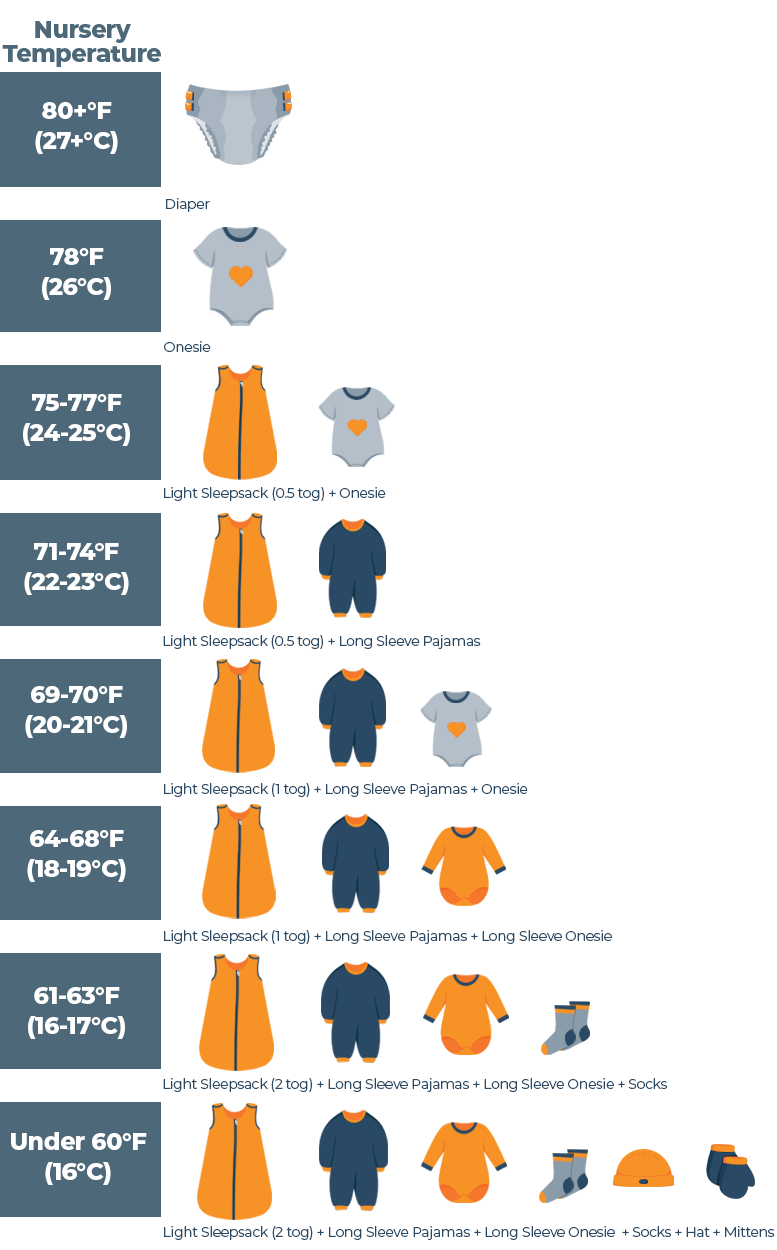As season’s change, it’s essential to keep your baby warm yet cool enough for a sound sleep. Keeping your home too hot can increase the risk of SIDS, so it’s critical not to go overboard on the heat. Additionally, individuals are more conducive to rest when they’re not too warm.
Ever flipped your pillow over to the cold side or taken off a layer when you’ve woken up too hot? Babies aren’t mobile in their earlier months, so it’s our job to make sure they stay comfortable through the night.
But how hot is too hot? And how cold is too cold? In this article, we’ll break down how to dress your baby for sleep in various temperatures so they get proper rest, allowing you all to wake up refreshed.
Basic Baby Sleep Temperature Guidelines
You may have heard of the term “TOG,” referring to how to dress a tot during the night. TOG refers to “thermal overall grade,” meaning about how many blankets to which a sleep sack is comparable.
A sleep sack is just what it sounds like; it’s a wearable sack for sleeping, made for babies. Clever, right? Sometimes our tots get caught up in a loose blanket, and these prevent this danger.
Wearable blankets are handy because babies can put their arms through them and still feel mobile while unable to wiggle out of the bottom sack-like design, keeping them cozy through the night. Grades of 1.2 and below are for warmer months, during spring and summer, and bags with grades of 2 to 2.5 are for cooler weather during winter and fall.
Read Our Guide: Best Sleep Sacks and Safe Sleeping Guidelines for Babies
Dressing Baby for Sleep in a 70 Degree Room
A good rule of thumb to remember when dressing your infant is to dress them in whatever you are comfortable wearing plus one additional layer. In a 70 degree room, you could put on one sleepsack worthy of 1 tog, or a lightweight swaddle blanket.
Temperature Chart

Every baby is different, and it can be tricky trying to tell if your infant is too hot or too cold. A good indication of their temperature is to feel their nose to see if it’s cold.
If your newborn’s hands turn slightly blue, don’t worry, this is normal, and they will cozy up quickly with a few cuddles and another layer of clothing. If they’re showing signs of sweat on their forehead or their chest feels warm, take a layer off.
Our chart will give you a solid starting point when dressing your babe; however, always trust your judgment. When assessing your little one’s temperature, finger and toes that are icy cold are likely to disrupt rest. Yet, if hands are just slightly cool to the touch, they’re likely okay.
Get More Info: What’s the Best Room Temperature for Baby?
Checking on Babies While They Are in Bed
If you’re concerned regarding the temperature of your sleepyhead during the night, it never hurts to go and check. Knowing your child best will help you when assessing their comfort level.
During the night, when monitoring their temperature, you can place your hand gently on their belly. If their tummy feels slightly warm, that’s a good indication they are comfortable, and their extremities will run slightly cooler.
If they’re running cold, you can heat them up without waking your munchkin by pulling on a pair of socks, mittens, or a hat to maintain warmth. Plus, extremities are often colder than their internal temperature but release heat more readily, so covering these will help to keep them warm.
Learn More: Parent’s Guide To a Child’s Sleep
Best Breathable Fabrics for Warm Nights
When it’s toastier out, your baby will probably appreciate lightweight, natural fabrics that allow their skin to breathe. A few good ones include cotton, linen, silk, hemp, cashmere, or wool. These are also good for layering, as they tend to prevent static cling yet still provide insulation.
Conclusion
Being that our children are unable to fend for themselves and can’t articulately express their needs, knowing what’s best for your baby can be challenging for any caregiver. However, being a parent involves continually learning new things about your tot, including how to dress them appropriately.
You may or may not get it right the first time, and that’s okay; you can always add or remove layers. While parenthood can be a world of stress, it also provides enormous teachable moments to learn about and bond with your sweet little bundle, paving the way for an enriching journey.
Sources and References:

Jill Zwarensteyn
Editor
About Author
Jill Zwarensteyn is the Editor for Sleep Advisor and a Certified Sleep Science Coach. She is enthusiastic about providing helpful and engaging information on all things sleep and wellness.
Combination Sleeper